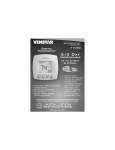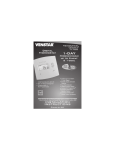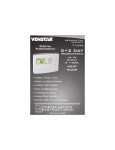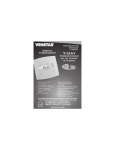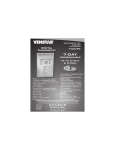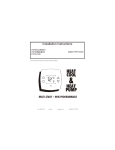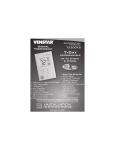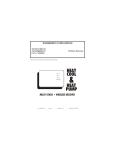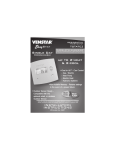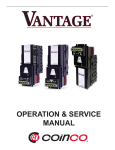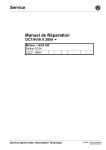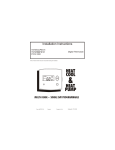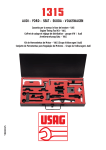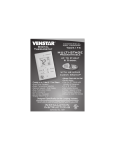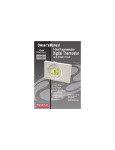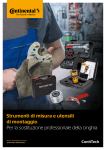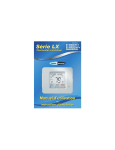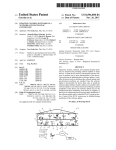Download Manual Venstar Install T1100REC Rev. 3
Transcript
residential WIRELESS THERMOSTAT RECEIVER Wireless Digital Thermostat Receiver T1100REC USE IN CONJUNCTION WITH T1100RF up to 2-heat & 2-cool HEAT COOL HEAT PUMP Control up to 2 Heat & 2 Cool Stages Wireless Operation Receives up to 4 Thermostats Flexible Installation Locations May be Mounted at Old Thermostat Location or with the Furnace Use with most Air Conditioning & Heating Systems including: 1 or 2 Stage Electric Cooling & 2 Stage Gas Heating, Heat Pump, Electric or Hydronic Heat. INSTALLATION INSTRUCTIONS Venstar Inc. 08/07 Table Of Contents Step #1: Preparation 2 Step #2: Remove & Replace Old Thermostat 3 Step #3: Dip Switch Settings 4 Step #4: Wire Connections 6 Step #5: Test Operation 15 Troubleshooting 16 CAUTION Follow Installation Instructions carefully. DISCONNECT POWER TO THE HEATER AIR CONDITIONER BEFORE REMOVING THE OLD THERMOSTAT AND INSTALLING THE NEW THERMOSTAT. WARNING This receiver is designed to operate from 0-70 C This device complies with Part 15 of the FCC Rules. Operation is subject to the following two conditions: (1) this device may not cause harmful interference, and (2) this device must accept any interference received, including interference that may cause undesired operation. P/N T1100REC Venstar Inc. 08/07 Page 1 c FC T1100REC FCC ID MUH-T10016 STEP #1 HEAT COOL FAN POWER HEAT COOL FAN PREPARATION Proper installation of the thermostat will be accomplished by following these step by step instructions. If you are unsure about any of these steps, call a qualified technician for assistance. Assemble tools. POWER Flat Blade Screwdriver HEAT COOL FAN POWER HEAT COOL FAN POWER HEAT COOL FAN POWER Wire cutter & Stripper Drill with 3/16 inch Drill Bit (when not using j-box) Make sure your Heater/Air Conditioner is working properly before beginning installation of the thermostat. Carefully unpack the thermostat. Save the screws, wall anchors, and instructions. Turn off the power to the Heating/Air Conditioning system at the main fuse panel. Most residential systems have a separate breaker for disconnecting power to the furnace. Page 2 STEP #2 HEAT COOL FAN POWER HEAT COOL FAN POWER HEAT COOL FAN POWER HEAT COOL FAN POWER REMOVE & REPLACE OLD THERMOSTAT Remove the cover of the old thermostat. If it does not come off easily check for screws. Loosen the screws holding the thermostat base or subbase to the wall, and lift away. Disconnect the wires from the old thermostat. Tape the ends of the wires as you disconnect them, and mark them with the letter of the terminal for easy reconnection to the new thermostat. Keep the old thermostat for reference purposes, until your new thermostat is functioning properly. Page 3 STEP #3 DIP SWITCH SETTINGS House Code Setting Antenna Dip switches ON 1 2 4 8 16 32 EH HP O/B Circuit Board 4 4 5 5 6 6 7 7 8 8 Example: House Code 10 2+8=10 9 9 If all of the number switches are set to OFF, then the House Code is 0 (zero). 1 2 4 8 16 32 EH HP O/B 3 3 Add all of the ON switches to arrive at the House Code number. All thermostats communicating with this receiver must have the same House Code number. ON ON Indicator 1 2 ON 1 2 1 2 4 8 16 32 EH HP O/B Disregard the numbers located on the actual dip switch and refer only to the markings on the Receiver circuit board. Page 4 Equipment Settings 5 6 7 The Reversing Valve polarity can also be set. OFF = O and ON = B. 8 9 ON 1 2 ON Indicator To configure the receiver for Electric Heat operation, slide the EH switch to the ON position as shown. 3 4 5 6 7 8 9 ON 1 2 3 4 5 6 ON Indicator To configure the receiver for Gas Heat operation, slide all of the equipment switches to the OFF position as shown. 7 8 9 1 2 4 8 16 32 EH HP O/B ON Indicator To configure the receiver for Heat Pump operation, slide the HP switch to the ON position as shown. 4 Gas Furnace 1 2 4 8 16 32 EH HP O/B 3 Electric Heat 1 2 4 8 16 32 EH HP O/B ON O or B Reversing Valve 1 2 Heat Pump Page 5 STEP #4 HEAT COOL FAN POWER WIRE CONNECTIONS If the terminal designations on your old thermostat do not match those on the new thermostat, refer to the chart below, or the wiring diagrams that follow. Wire from the old thermostat terminal marked Function G or F Fan Install on the new thermos tat connector marked G Y1, Y or C Cooling Y1 W1, W or H Heating W1, O, B Rh, R, M, Vr, A Power R C Common C* W1, O, B** O/B Rev. Valve Y2 2nd Stage Cool Y2 W2 2nd Stage Heat W2 * C may not be used on all systems. ** O/B is used if your system is a Heat Pump. Page 6 Sample Wiring Diagrams Gas or Electric Heat 5 Wire, 1 Stage Cooling, 1 Stage Gas Heat Residential Gas or Electric Heat*, Electric Cool, split systems & package units. GAS VALVE or STRIP HEAT W POWER R COMPRESSOR G FAN Y COMMON C W1 O C G Y1 B R Y2 W2 * If using first stage electric heat, the “EH” dip switch must be set to ON (see page 5). Page 7 Sample Wiring Diagrams Gas or Electric Heat 4 Wire, 1 Stage Cooling, 1 Stage Gas Heat Residential Gas or Electric Heat*, Electric Cool, split systems & package units. GAS VALVE or STRIP HEAT W POWER R COMPRESSOR Y FAN G W1 O C G Y1 B R Y2 W2 * If using first stage electric heat, the “EH” dip switch must be set to ON (see page 5). Page 8 Sample Wiring Diagrams Gas or Electric Heat 2 Wire, 1 Stage Gas or Electric Heat W1 O C G Y1 B R Y2 W2 R W Furnace Board White Red 24V Relay Brown Black Orange Black 24VAC 200mA Adaptor The ACC0436 Wireless Thermostat Two-Wire Kit can be purchased separately. * If using first stage electric heat, the “EH” dip switch must be set to ON (see page 5). Page 9 Sample Wiring Diagrams Gas or Electric Heat 6 Wire, 2 Stage Cooling, 1 Stage Gas Heat Residential two stage cooling with Gas or Electric Heat.* GAS VALVE or STRIP HEAT W POWER R 2nd STAGE COOLING Y2 COMPRESSOR G FAN Y COMMON C W1 O C G Y1 B R Y2 W2 * If using first stage electric heat, the “EH” dip switch must be set to ON (see page 5). Page 10 Sample Wiring Diagrams Gas or Electric Heat 6 Wire, 1 Stage Cooling, 2 Stage Heat Residential & Commercial 1 Stage Cooling, with 2 Stage Gas or Electric Heat.* GAS VALVE or STRIP HEAT W POWER R 2nd STAGE HEATING W2 COMPRESSOR G FAN Y COMMON C W1 O C G Y1 B R Y2 W2 * If using first stage electric heat, the “EH” dip switch must be set to ON (see page 5). Page 11 Sample Wiring Diagrams Gas or Electric Heat 7 Wire, 2 Stage Cooling, 2 Stage Heat Commercial Gas or Electric Heat*, Electric Cool, split systems & package units including Commercial Heat Pumps.** GAS VALVE or STRIP HEAT W POWER R 2nd STAGE COOLING 2nd STAGE HEATING W2 Y2 COMPRESSOR G FAN Y COMMON C W1 O C G Y1 B R Y2 W2 * If using first stage electric heat, the “EH” dip switch must be set to ON (see page 5). ** If using a Commercial heat pump, the “HP” dip switch must be set to OFF (see page 5). Page 12 Sample Wiring Diagrams Heat Pump 5 Wire, 1 Stage Cooling, 1 Stage Heat, Heat Pump* with O or B reversing valve**. Residential Heat Pumps, split systems & package units, with no auxiliary heat. REVERSING VALVE** O/B POWER R COMPRESSOR G FAN Y COMMON C W1 O C G Y1 B R Y2 W2 * The “HP” dip switch must be set to ON (see page 5). ** The “O/B” dip switch must be set to O or B (see page 5). Page 13 Sample Wiring Diagrams Heat Pump 6 Wire, 1 Stage Cooling, 2 Stage Heat, Heat Pump* with O or B reversing valve**. Residential Heat Pumps, split systems & package units, with auxiliary heat. COMPRESSOR Y REVERSING VALVE** O/B POWER R 2nd STAGE HEATING W2 FAN G COMMON C W1 O C G Y1 B R Y2 W2 * The “HP” dip switch must be set to ON (see page 5). ** The “O/B” dip switch must be set to O or B (see page 5). Page 14 STEP #5 HEAT HEAT COOL COOL FAN POWER FAN POWER HEAT HEAT COOL COOL FAN POWER FAN POWER HEAT HEAT COOL COOL FAN POWER FAN POWER TEST OPERATION Turn the power on to the Heating/Air Conditioning system. Press the MODE button repeatedly until the HEAT icon appears on the display. Press the UP or DOWN button until the set temperature is 10 degrees above room temperature. The HVAC unit should energize in the heating mode. Press the MODE button repeatedly until the COOL icon appears on the display. Press the UP or DOWN button until the set temperature is 10 degrees below room temperature. The HVAC unit should energize in the cooling mode. NOTE: Most equipment has a time delay of 5 minutes between cooling cycles. This feature is defeatable on the thermostat (see page 13, step 8 of the Thermostat Manual). HEAT HEAT COOL COOL FAN POWER FAN POWER Press the UP button until the setpoint is equal to the room temperature. Press the FAN button to Fan On. The fan should turn on and run continuously. Page 15 TROUBLESHOOTING HEAT COOL FAN POWER SYMPTOM: When using 4 wires (R, G, W, Y), the air conditioning or heating equipment tries repeatedly to turn on, but cannot. CAUSE: There is not enough power available to "power share". REMEDY: Connect a 250 ohm, 10 watt power resistor at the furnace as shown below. For Problem A/C R G W Y For Problem Heat C R TR300-10w G W Y C TR300-10w Note: 2 resistors may be used at the same time. Not applicable with Heat Pump systems. HEAT COOL FAN POWER HEAT COOL FAN POWER SYMPTOM: The air conditioning does not attempt to turn on. CAUSE: The compressor timer lockout may prevent the air conditioner from turning on for a period of time. REMEDY: See page 13 of the Thermostat Manual and configure step 8 to defeat the 5-minute compressor lockout. SYMPTOM: The display is blank. CAUSE: Lack of proper power. REMEDY: Make sure power is turned on to the furnace and 24vac exists between R & W. If C is used, 24vac between R & C. Page 16 TROUBLESHOOTING HEAT COOL FAN POWER HEAT COOL FAN POWER SYMPTOM: When controlling a residential heat pump, and asking for cooling, the heat comes on. CAUSE: The Heat Pump dip switch is set to OFF. REMEDY: See page 5 of this manual and set the Heat Pump (HP) switch to ON. SYMPTOM: When calling for cooling, both the heat and cool come on. CAUSE: The Heat Pump dip switch is set to ON and the HVAC system is a "conventional" (non-heat pump) system. REMEDY: See page 5 of this manual and set the Heat Pump (HP) switch to OFF to enable gas electric operation. Receiver T1100REC c FC Tested to Comply with FCC Standards FOR HOME OR OFFICE USE 4Z95 P/N 88-615 Rev. 3 Page 17


















